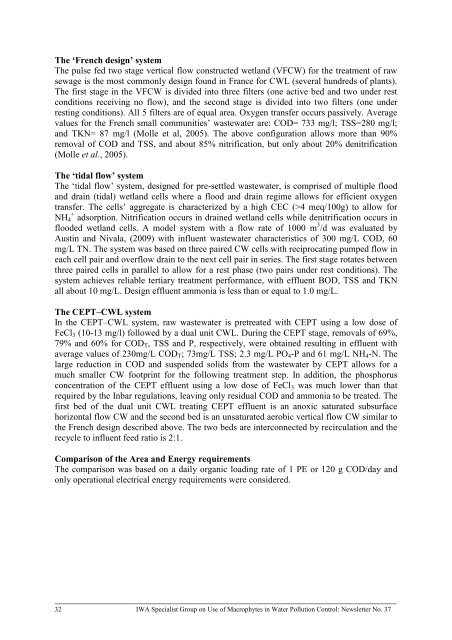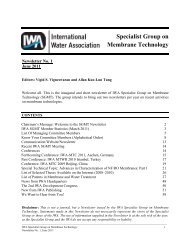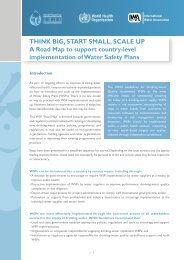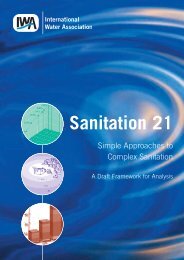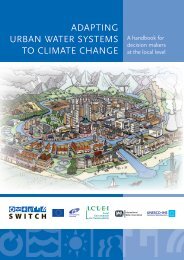Specialist Group on Use of Macrophytes in Water Pollution ... - IWA
Specialist Group on Use of Macrophytes in Water Pollution ... - IWA
Specialist Group on Use of Macrophytes in Water Pollution ... - IWA
Create successful ePaper yourself
Turn your PDF publications into a flip-book with our unique Google optimized e-Paper software.
The ‘French design’ system<br />
The pulse fed two stage vertical flow c<strong>on</strong>structed wetland (VFCW) for the treatment <strong>of</strong> raw<br />
sewage is the most comm<strong>on</strong>ly design found <strong>in</strong> France for CWL (several hundreds <strong>of</strong> plants).<br />
The first stage <strong>in</strong> the VFCW is divided <strong>in</strong>to three filters (<strong>on</strong>e active bed and two under rest<br />
c<strong>on</strong>diti<strong>on</strong>s receiv<strong>in</strong>g no flow), and the sec<strong>on</strong>d stage is divided <strong>in</strong>to two filters (<strong>on</strong>e under<br />
rest<strong>in</strong>g c<strong>on</strong>diti<strong>on</strong>s). All 5 filters are <strong>of</strong> equal area. Oxygen transfer occurs passively. Average<br />
values for the French small communities‘ wastewater are: COD= 733 mg/l; TSS=280 mg/l;<br />
and TKN= 87 mg/l (Molle et al, 2005). The above c<strong>on</strong>figurati<strong>on</strong> allows more than 90%<br />
removal <strong>of</strong> COD and TSS, and about 85% nitrificati<strong>on</strong>, but <strong>on</strong>ly about 20% denitrificati<strong>on</strong><br />
(Molle et al., 2005).<br />
The ‘tidal flow’ system<br />
The ‗tidal flow‘ system, designed for pre-settled wastewater, is comprised <strong>of</strong> multiple flood<br />
and dra<strong>in</strong> (tidal) wetland cells where a flood and dra<strong>in</strong> regime allows for efficient oxygen<br />
transfer. The cells‘ aggregate is characterized by a high CEC (>4 meq/100g) to allow for<br />
NH4 + adsorpti<strong>on</strong>. Nitrificati<strong>on</strong> occurs <strong>in</strong> dra<strong>in</strong>ed wetland cells while denitrificati<strong>on</strong> occurs <strong>in</strong><br />
flooded wetland cells. A model system with a flow rate <strong>of</strong> 1000 m 3 /d was evaluated by<br />
Aust<strong>in</strong> and Nivala, (2009) with <strong>in</strong>fluent wastewater characteristics <strong>of</strong> 300 mg/L COD, 60<br />
mg/L TN. The system was based <strong>on</strong> three paired CW cells with reciprocat<strong>in</strong>g pumped flow <strong>in</strong><br />
each cell pair and overflow dra<strong>in</strong> to the next cell pair <strong>in</strong> series. The first stage rotates between<br />
three paired cells <strong>in</strong> parallel to allow for a rest phase (two pairs under rest c<strong>on</strong>diti<strong>on</strong>s). The<br />
system achieves reliable tertiary treatment performance, with effluent BOD, TSS and TKN<br />
all about 10 mg/L. Design effluent amm<strong>on</strong>ia is less than or equal to 1.0 mg/L.<br />
The CEPT–CWL system<br />
In the CEPT–CWL system, raw wastewater is pretreated with CEPT us<strong>in</strong>g a low dose <strong>of</strong><br />
FeCl3 (10-13 mg/l) followed by a dual unit CWL. Dur<strong>in</strong>g the CEPT stage, removals <strong>of</strong> 69%,<br />
79% and 60% for CODT, TSS and P, respectively, were obta<strong>in</strong>ed result<strong>in</strong>g <strong>in</strong> effluent with<br />
average values <strong>of</strong> 230mg/L CODT; 73mg/L TSS; 2.3 mg/L PO4-P and 61 mg/L NH4-N. The<br />
large reducti<strong>on</strong> <strong>in</strong> COD and suspended solids from the wastewater by CEPT allows for a<br />
much smaller CW footpr<strong>in</strong>t for the follow<strong>in</strong>g treatment step. In additi<strong>on</strong>, the phosphorus<br />
c<strong>on</strong>centrati<strong>on</strong> <strong>of</strong> the CEPT effluent us<strong>in</strong>g a low dose <strong>of</strong> FeCl3 was much lower than that<br />
required by the Inbar regulati<strong>on</strong>s, leav<strong>in</strong>g <strong>on</strong>ly residual COD and amm<strong>on</strong>ia to be treated. The<br />
first bed <strong>of</strong> the dual unit CWL treat<strong>in</strong>g CEPT effluent is an anoxic saturated subsurface<br />
horiz<strong>on</strong>tal flow CW and the sec<strong>on</strong>d bed is an unsaturated aerobic vertical flow CW similar to<br />
the French design described above. The two beds are <strong>in</strong>terc<strong>on</strong>nected by recirculati<strong>on</strong> and the<br />
recycle to <strong>in</strong>fluent feed ratio is 2:1.<br />
Comparis<strong>on</strong> <strong>of</strong> the Area and Energy requirements<br />
The comparis<strong>on</strong> was based <strong>on</strong> a daily organic load<strong>in</strong>g rate <strong>of</strong> 1 PE or 120 g COD/day and<br />
<strong>on</strong>ly operati<strong>on</strong>al electrical energy requirements were c<strong>on</strong>sidered.<br />
___________________________________________________________________________<br />
32 <strong>IWA</strong> <str<strong>on</strong>g>Specialist</str<strong>on</strong>g> <str<strong>on</strong>g>Group</str<strong>on</strong>g> <strong>on</strong> <strong>Use</strong> <strong>of</strong> <strong>Macrophytes</strong> <strong>in</strong> <strong>Water</strong> Polluti<strong>on</strong> C<strong>on</strong>trol: Newsletter No. 37


